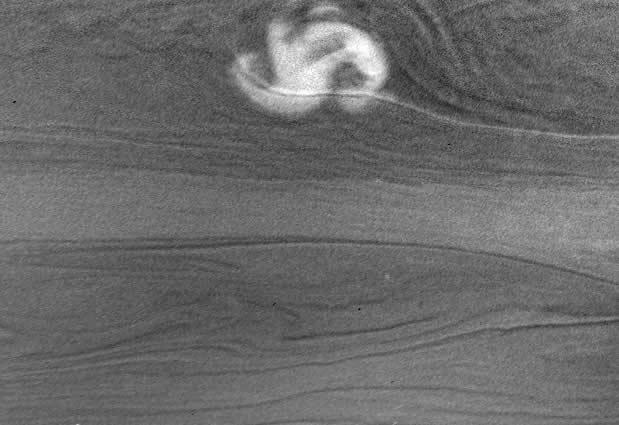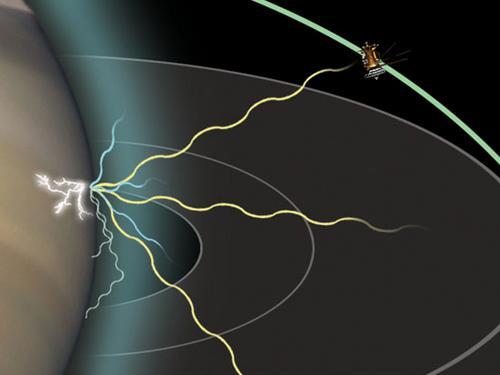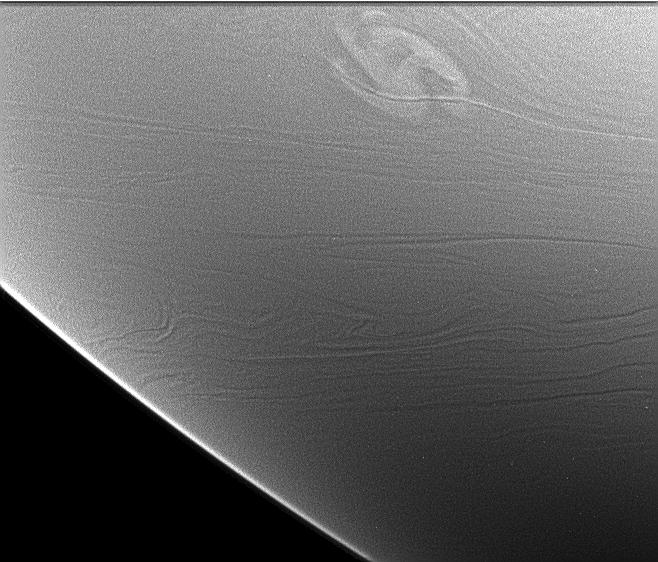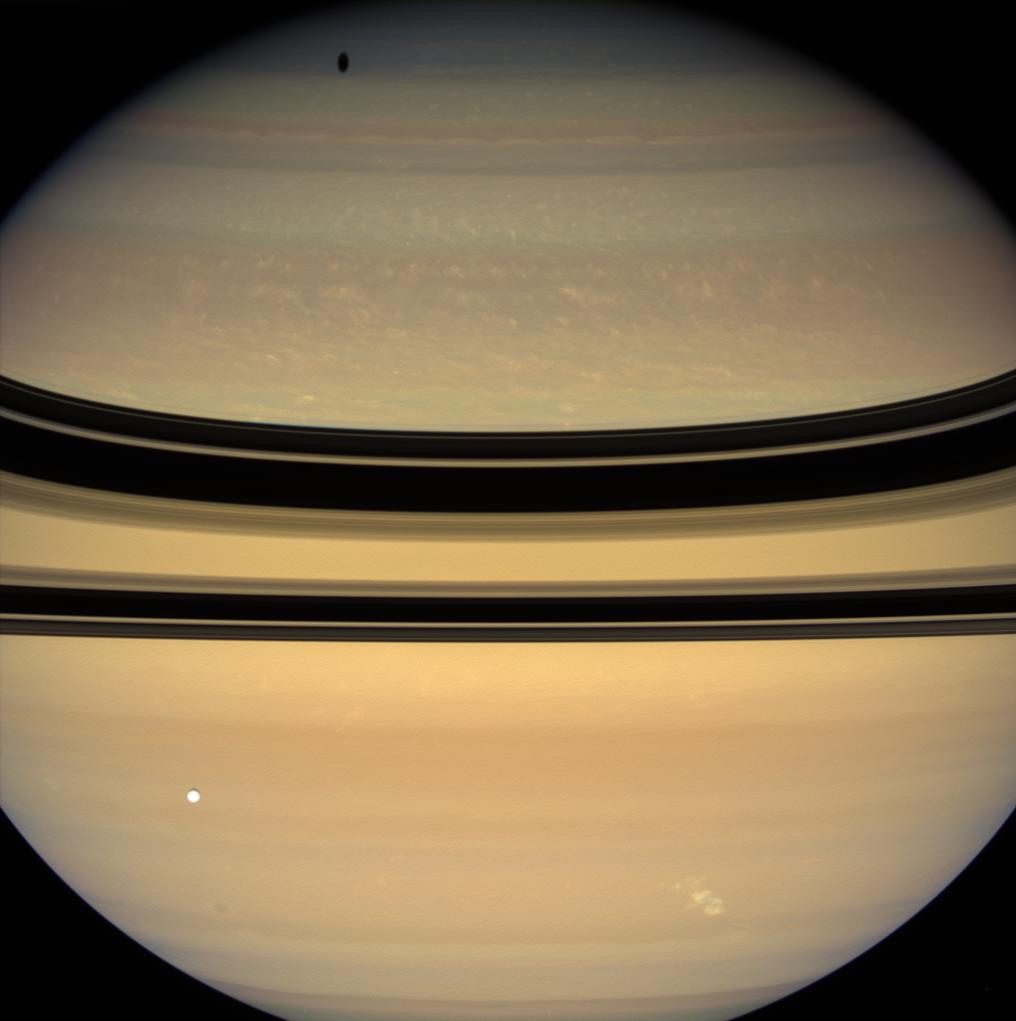|
The Enigmas on Saturn |
||
|
.
Light reflected from Saturn's
rings provided enough illumination for Cassini's
cameras to snap clouds
from the mega-storm on 27 January 2006, even
though Cassini was in the
planet's shadow (Image: NASA/JPL/Space Science
Institute)
17:23 15
February 2006
The most powerful lightning storm ever detected on Saturn has been captured by the Cassini spacecraft – but scientists are still not sure what is causing it. Cassini's Radio and Plasma Wave Science (RPWS) instrument captured the first radio noise from the storm on 23 January 2006. But the storm continued to rage and scientists have recorded at least 25 strong episodes of lightning activity since. "It is clear that this is the strongest lightning activity that we've seen with Cassini since it arrived at Saturn," says Donald Gurnett at the University of Iowa, US, and RPWS principal investigator. "In fact, the flash rate even exceeds the rate observed by Voyager 1 back in 1980 and the intensities are at least as large, if not larger." The lightning bolts are more than 1000 times stronger than those on Earth – listen to them here. The storm covers an area larger than the continental US, at a southern latitude around 36°. This region is known as "Storm Alley" because Cassini has observed so many storms there since it reached Saturn in July 2004.
Backyard Astronomers "With Cassini, we have learned that lightning storms can emerge suddenly and last for several weeks or even a month," says team member Georg Fischer at the University of Iowa. It is not clear what causes such powerful storms, but the team has previously suggested that temperature differences between sunlit areas and regions shaded by the planet's famous rings may be to blame. Cassini was on the planet's night side when the storm began, so mission scientists were not sure that its imaging instruments see the storm, although they could hear it. They asked amateur astronomers if they had seen any storm clouds from the same region, and within two hours, two backyard observers near Paris, France, had posted an image of a white cloud from the tempest taken on 25 January. Since then, Cassini's cameras have also captured storm clouds from the event that were faintly illuminated by sunlight reflected the planets rings. Mission scientists hope the cameras will capture lightning on the planet's night side – and pinpoint the storm's location more accurately – when Cassini's orbit takes it closer to the planet in the coming weeks. SOURCE: New Scientist |
||
|
. NewScientist.com news service Maggie McKee "Superbolts" of lightning burst in erratic thunderstorms on Saturn, reveals new data from the Cassini spacecraft, challenging previous observations of static storms. The orbiting spacecraft has observed unpredictable storm patterns, not observed by the Voyager spacecraft more than 20 years ago. Cassini has also revealed a new radiation belt just above the planet’s cloud tops – far closer than any previously observed radiation belts around the ringed planet. Lightning produces radio emissions as well as visible light, and in 1980 and 1981, NASA's two Voyager spacecraft each spent a few days listening to Saturn's storms during flybys. The storms seemed eerily unchanging, firing off the same number of lightning bursts as they whipped around the planet every 10 hours. Now, astronomers eavesdropping with the US-European spacecraft Cassini, which went into orbit around Saturn on 1 July 2004, are hearing a different story. "We're seeing lightning strokes during some rotations but not others - sometimes they seem very intense, others not," says Bill Kurth, an astronomer at the University of Iowa in Iowa City, US, who is studying the storms with Cassini's radio and plasma wave instrument. The storms appear to take 40 minutes longer to travel around Saturn than those 24 years ago. That suggests they are riding slower jet streams at higher latitudes, which hints at a cause in the planet's famous rings Sun-kissed areas Saturn orbits the Sun every 29 years, and as it does so, the 27-degree tilt of its axis make the rings cast different shadows on the planet. Today, it is summer in Saturn's southern hemisphere, and the rings cast a widespread shadow across the planet's northern face. But during the Voyager flybys, the Sun hit the rings nearly edge-on so that Saturn's equator was constantly shaded. The drastic temperature difference between the cool shaded belt and the surrounding sun-kissed areas may have fuelled regular convection patterns that drove Saturn's static storms, says Kurth. But he cautions the theory is just a "hunch". "I can think of other theories," agrees Andrew Ingersoll, a planetary scientist at the California Institute of Technology who has studied Jupiter's lightning storms. "There's a certain element of luck when you talk about weather. It's possible there were no equatorial storms during the past few months but there was one when Voyager went by." Water and ice "Sometimes you get fooled observing over short periods of time," concedes Kurth. "That's one of the advantages of being in orbit and hanging around so you can see if the storm systems evolve over months or years." At the end of Cassini's mission in 2008, the rings' orientation will be similar to that seen by the Voyagers, so Kurth can test his shadow theory. Jupiter's storms, which may be similar to Saturn's, span about 1000 kilometres and feature "superbolts" of lightning about three times brighter than the brightest bolts on Earth. But aside from the storms' super size, they are probably quite similar to Earth's - born of charge separation between water and ice in clouds and driven by convection. The rain clouds are buried 80 kilometres into the atmospheres of Jupiter and Saturn, but astronomers have seen faint flashes from lightning on Jupiter's dark side. Saturn's rings reflected too much sunlight to reveal the flickers to the Voyager probes, but imaging instruments on Cassini may be able to capture them. SOURCE: New Scientist |
||
|
04.29.08 ... A bright, powerful, lightning-producing storm churns and coasts along the lane of Saturn's southern hemisphere nicknamed "Storm Alley" by scientists. NASA's Cassini spacecraft detected this particular tempest after nearly two years during which Saturn did not appear to produce any large electrical storms of this kind. The storm appears as a bright, irregular splotch on the planet near lower right. Lightning flashes within the persistent storm produce radio waves, called Saturn Electrostatic Discharges, which the Cassini radio and plasma wave science instrument first detected on Nov. 27, 2007. Cassini's imaging cameras then spotted the storm, taking the images used to create this color view about a week later on Dec. 6. This electrical storm is similar in appearance and intensity to those previously monitored by Cassini. All of these powerful electrostatic producing storms appeared at about 35 degrees south latitude on Saturn. (See PIA07788, PIA08142 and PIA06197 for additional images of Saturn's electrical storms imaged by Cassini.) This storm has now been continuously tracked by Cassini for several months, whereas previous storms observed by the spacecraft lasted for less than 30 days: See PIA08411 for images of the storm acquired three months after this view. The view looks toward the un-illuminated side of the rings from about 5 degrees above the ringplane. Tethys (1,071 kilometers, or 665 miles across) is seen here in the foreground, and casts its shadow onto the high northern latitudes. Images taken using red, green and blue spectral filters were combined to create this natural color view. The images were acquired with the Cassini spacecraft wide-angle camera at a distance of approximately 1.7 million kilometers (1 million miles) from Saturn. Image scale is 97 kilometers (60 miles) per pixel. The Cassini-Huygens mission is a cooperative project of NASA, the European Space Agency and the Italian Space Agency. The Jet Propulsion Laboratory, a division of the California Institute of Technology in Pasadena, manages the mission for NASA's Science Mission Directorate, Washington, D.C. The Cassini orbiter and its two onboard cameras were designed, developed and assembled at JPL. The imaging operations center is based at the Space Science Institute in Boulder, Colo. The radio and plasma wave science team is based at the University of Iowa, Iowa City. For more information about the Cassini-Huygens mission visit http://saturn.jpl.nasa.gov . The Cassini imaging team homepage is at http://ciclops.org. The radio and plasma wave science instrument team home page is at: http://www-pw.physics.uiowa.edu/plasma-wave/cassini/home.html Credit: NASA/JPL/Space Science Institute |
||
|
February 24, 2005 . A giant storm system nicknamed
‘the dragon’ reaches into the upper atmosphere
of Saturn in this recent
image from the Cassini spacecraft. Cassini also
detected the radio ‘crackle’
of powerful bursts of lightning from the storm.
This image was shot with
special filters to enhance details in the
clouds. The dragon is the wispy
structure above the center of the image. Credit:
NASA/JPL/Space Science
Institute
The Dragon Storm A large, bright and complex convective storm that appeared in Saturn's southern hemisphere in mid-September 2004 was the key in solving a long-standing mystery about the ringed planet. Saturn's atmosphere and its rings are shown here in a false color composite made from images taken in near infrared light through filters that sense different amounts of methane gas. Portions of the atmosphere with a large abundance of methane above the clouds are red, indicating clouds that are deep in the atmosphere. Grey indicates high clouds, and brown indicates clouds at intermediate altitudes. The rings are bright blue because there is no methane gas between the ring particles and the camera. The complex feature with arms and secondary lobes just above and to the right of center is called the Dragon Storm. It lies in a region of the southern hemisphere referred to as "storm alley" by imaging scientists because of the high level of storm activity observed there by Cassini in the last year. The Dragon Storm was a powerful source of radio emissions during July and September of 2004. The radio waves from the storm resemble the short bursts of static generated by lightning on Earth. Cassini detected the bursts only when the storm was rising over the horizon on the night side of the planet as seen from the spacecraft; the bursts stopped when the storm moved into sunlight. This on/off pattern repeated for many Saturn rotations over a period of several weeks, and it was the clock-like repeatability that indicated the storm and the radio bursts are related. Scientists have concluded that the Dragon Storm is a giant thunderstorm whose hail and cloud droplets generate electricity as they do on Earth. The storm may be deriving its energy from Saturn's deep atmosphere. One mystery is why the radio bursts start while the Dragon Storm is below the horizon on the night side and end when the storm is on the day side, still in full view of the Cassini spacecraft. A possible explanation is that the lightning source lies to the east of the visible cloud, perhaps because it is deeper where the currents are eastward relative to those at cloud top levels. If this were the case, the lightning source would come up over the night side horizon and would sink down below the day side horizon before the visible cloud. This would explain the timing of the visible storm relative to the radio bursts. The Dragon Storm is of great interest for another reason. In examining images taken of Saturn's atmosphere over many months, imaging scientists found that the Dragon Storm arose in the same part of Saturn's atmosphere that had earlier produced large bright convective storms. In other words, the Dragon Storm appears to be a long-lived storm deep in the atmosphere that periodically flares up to produce dramatic bright white plumes which subside over time. One earlier sighting, in July 2004, was also associated with strong radio bursts. And another, observed in March 2004 and captured in a movie created from images of the atmosphere (PIA 06082, 06083) spawned three little dark oval storms that broke off from the arms of the main storm. Two of these subsequently merged with each other; the current to the north carried the third one off to the west, and Cassini lost track of it. Small dark storms like these generally get stretched out until they merge with the opposing currents to the north and south. These little storms are the food that sustains the larger atmospheric features, including the larger ovals and the eastward and westward currents. If the little storms come from the giant thunderstorms, then together they form a food chain that harvests the energy of the deep atmosphere and helps maintain the powerful currents. Cassini has many more chances to observe future flare-ups of the Dragon Storm, and others like it over the course of the mission. It is likely that scientists will come to solve the mystery of the radio bursts and observe storm creation and merging in the next 2 or 3 years. The Cassini-Huygens mission is a cooperative project of NASA, the European Space Agency and the Italian Space Agency. The Jet Propulsion Laboratory, a division of the California Institute of Technology in Pasadena, manages the Cassini-Huygens mission for NASA's Science Mission Directorate, Washington, D.C. The imaging team consists of scientists from the US, England, France, and Germany. The imaging operations center and team lead (Dr. C. Porco) are based at the Space Science Institute in Boulder, Colo. For more information about the Cassini-Huygens mission, visit http://saturn.jpl.nasa.gov and the Cassini imaging team home page, http://ciclops.org. Credit: NASA/JPL/Space Science Institute |
||
|
04.29.08 .. An enhanced color view of a storm
on Saturn. The larger view includes a view
showing Saturn in colors that
approximate what the human eye would see. Image
credit: NASA/JPL/Space
Science Institute
PASADENA, Calif. – As a powerful electrical storm rages on Saturn with lightning bolts 10,000 times more powerful than those found on Earth, the Cassini spacecraft continues its five-month watch over the dramatic events. Scientists with NASA's Cassini-Huygens mission have been tracking the visibly bright, lightning-generating storm--the longest continually observed electrical storm ever monitored by Cassini. Saturn's electrical storms resemble terrestrial thunderstorms, but on a much larger scale. Storms on Saturn have diameters of several thousand kilometers (thousands of miles), and radio signals produced by their lightning are thousands of times more powerful than those produced by terrestrial thunderstorms. Color images of the storm are available at: http://saturn.jpl.nasa.gov and http://www.nasa.gov/cassini and http://ciclops.org . Lightning flashes within the persistent storm produce radio waves called Saturn electrostatic discharges, which the radio and plasma wave science instrument first detected on Nov. 27, 2007. Cassini's imaging cameras monitored the position and appearance of the storm, first spotting it about a week later, on Dec. 6. "The electrostatic radio outbursts have waxed and waned in intensity for five months now," said Georg Fischer, an associate with the radio and plasma wave science team at the University of Iowa, Iowa City. "We saw similar storms in 2004 and 2006 that each lasted for nearly a month, but this storm is longer-lived by far. And it appeared after nearly two years during which we did not detect any electrical storm activity from Saturn." The new storm is located in Saturn's southern hemisphere--in a region nicknamed "Storm Alley" by mission scientists--where the previous lightning storms were observed by Cassini. "In order to see the storm, the imaging cameras have to be looking at the right place at the right time, and whenever our cameras see the storm, the radio outbursts are there," said Ulyana Dyudina, an associate of the Cassini imaging team at the California Institute of Technology in Pasadena, Calif. Cassini's radio plasma wave instrument detects the storm every time it rotates into view, which happens every 10 hours and 40 minutes, the approximate length of a Saturn day. Every few seconds the storm gives off a radio pulse lasting for about a tenth of a second, which is typical of lightning bolts and other electrical discharges. These radio waves are detected even when the storm is over the horizon as viewed from Cassini, a result of the bending of radio waves by the planet's atmosphere. Amateur astronomers have kept track of the storm over its five-month lifetime. "Since Cassini's camera cannot track the storm every day, the amateur data are invaluable," said Fischer. "I am in continuous contact with astronomers from around the world." The long-lived storm will likely provide information on the processes powering Saturn's intense lightning activity. Cassini scientists will continue to monitor Storm Alley as the seasons change, bringing the onset of autumn to the planet’s southern hemisphere. The Cassini-Huygens mission is a cooperative project of NASA, the European Space Agency and the Italian Space Agency. JPL, a division of Caltech, manages the Cassini mission for NASA's Science Mission Directorate, Washington, D.C. The Cassini orbiter and its two onboard cameras were designed, developed and assembled at JPL. The imaging team is based at the Space Science Institute, Boulder, Colo. The radio and plasma wave science team is based at the University of Iowa, Iowa City. |
||
| FAIR USE NOTICE: This page contains copyrighted material the use of which has not been specifically authorized by the copyright owner. Pegasus Research Consortium distributes this material without profit to those who have expressed a prior interest in receiving the included information for research and educational purposes. We believe this constitutes a fair use of any such copyrighted material as provided for in 17 U.S.C § 107. If you wish to use copyrighted material from this site for purposes of your own that go beyond fair use, you must obtain permission from the copyright owner. | ||
|
|






